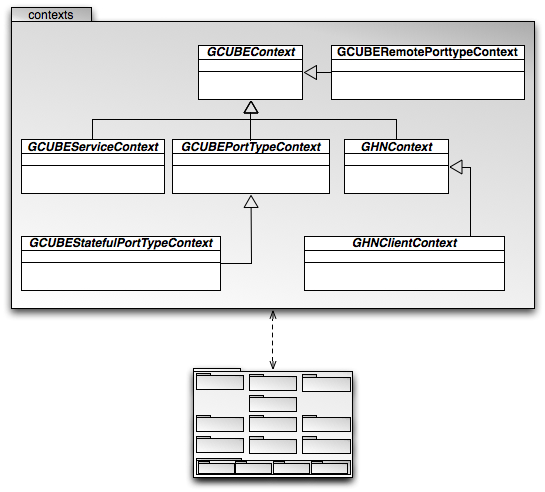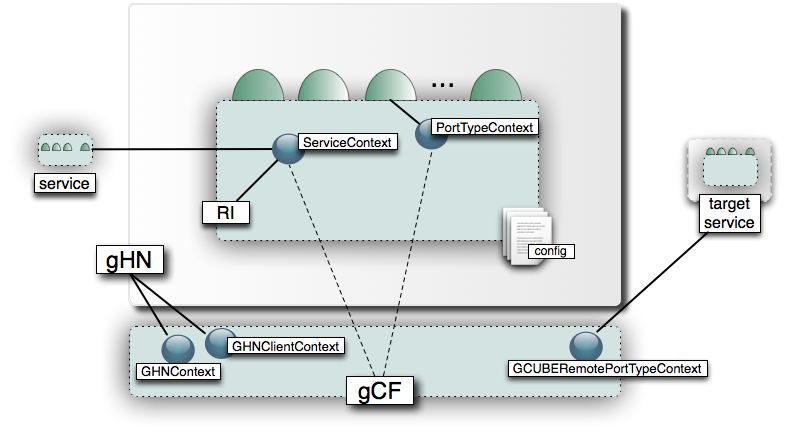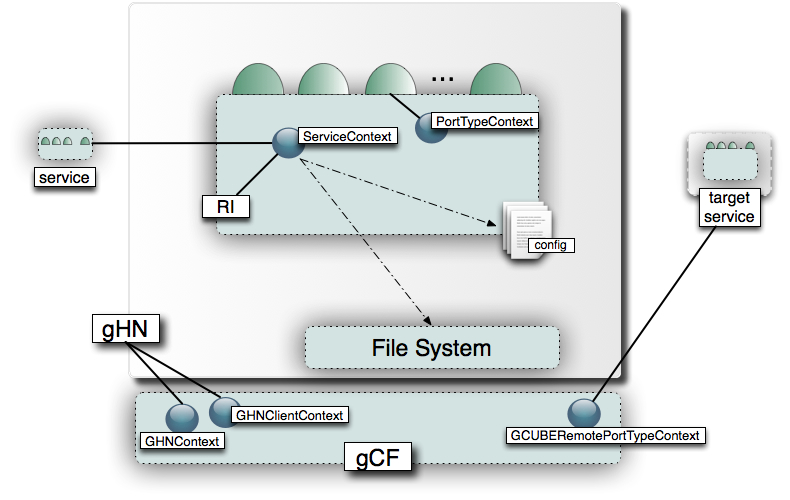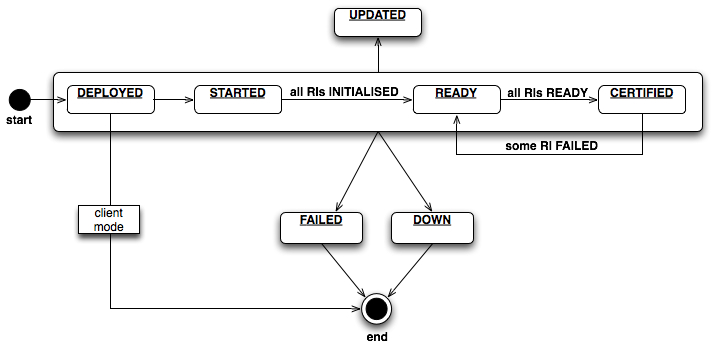Contexts
Within service implementations, some functionality needs to be accessed by different components and for different purposes.
The most obvious case of shared functionality is the functionality required to expose the configuration of the service, or the configuration of its RI, or the configuration of the gHN on which the RI is deployed. There is also information related to scope and security which is dynamically acquired and simultaneously needed by different components. And moving beyond information access, there are utilities and behaviours, both general-purpose and service-specific, which may be called upon from multiple and functionally unrelated components.
The gCF approach to shared functionality is to centralise it in distinguished components, called contexts, which are directly accessible from any other implementation component. gCF contexts are singleton classes, in that they are designed to be instantiated only once and to expose the single instance to all their clients in a thread-safe manner.
There are different type of contexts in gCF, each of which centralises functionality that is conceptually associated with key entities of service implementations: the service and its RI, the gHN on which the RI is deployed, the port-types of the service, and even the port-types of the target services of the RI. Some are fully defined within gCF (e.g. the context of the gHN). Others are only partially implemented and need to be specialised within service implementations. Collectively, the context form a inheritance hierarchy contained in the contexts package:
As shown in the diagram, the entire framework has dependencies on the contexts packages, in line with the definition of contexts as repositories of shared functionality. The high-level roles of the components in the package is summarised below:
-
GCUBEContext: the base implementation for all contexts in gCF.
-
GCUBEGHNContext: a concrete specialisation ofGCUBEContextfor a gCube Hosting Node.
-
GCUBEServiceContext: a concrete specialisation ofGCUBEContextfor a gCube Service and its RIs.
-
GCUBEPortTypeContext: a concrete specialisation ofGCUBEContextfor a port-type of gCube Service.
-
GCUBEStatefulPortTypeContext: a concrete specialisation ofGCUBEPortTypeContextfor a stateful port-type of a gCube Service.
-
GCUBERemotePortTypeContext: a concrete specialisation ofGCUBEContextfor a port-type of a target gCube Service.
Before discussing each context class in detail, we refine our the service model to introduce key context classes from the perspective of the service developer:
The figure shows that the GHNContext and GCUBERemotePortTypeContext are fully implemented by the framework and live outside the boundary of specific service implementations. In contrast, service and the port-type contexts fall in the scope of service implementations as specialisations of gCF context classes.
Contents
Common Facilities
All gCF contexts offer basic facilities for configuration and local file management.
The primary form of configuration supported by gC contexts is based on named access to arbitrary objects. The underlying configuration mechanism is based on a dedicated implementation of the JNDI interface; in particular, gCF contexts act as a wrappers of standard JNDI contexts and offer a much simplified interface to named access.
The underlying JNDI implementation remains opaque to both clients and implementers of context classes. Developers are
only exposed to the configuration files that are then used to populate the JNDI implementation wrapped by the contexts. As we discuss below,
the direct subclasses of GCUBEContext are responsible for establishing conventions on the naming and location of such files, for the
definition and documentation of pre-defined configuration properties, and for loading all the configuration properties from the files.
As most service developers specialise these subclasses, they need only to author the configuration files.
The syntax for authoring JNDI configuration is based on XML, and its definition is lifted from technologies that underlies gCF. Conventions on context-specific configuration authoring are discussed below in relation to each type of context.
As to file management, gCF contexts offers facilities to access:
- files stored in the local file system for reading or writing purposes. Here the main goal is to abstract over the location in which the files are stored and thus to avoid gHN-specific dependencies. While actual location in which files are stored is specific to the type of context, as we discuss below, all contexts offer basic backup facilities: transparently to their clients, they create copies of files that are about to be modified and used backups whenever the original files are corrupted. In the second case, access is read-only
- files packaged along with the context, or more generally on the classpath, for read-only purposes.
In both cases, the gCF contexts are agnostic to the content of the files. This may be service-specific configuration that lives outside the standard JNDI framework, or any form of state that is deemed suitable for file storage.
The basic operations for configuration and file management are following (see the code documentation for signature details):
-
getProperty(name,mandatory?): resolves a configuration property from its name. An optional flag indicates whether the presence property is deemed mandatory or else is optional (default). The flag is used for error and log management purposes. getResource(path): returns a classpath file resource given its path. A relative path is resolved with respect to the context implementation, while an absolute path is resolved directly against the classpath.getFile(path,mode): returns ajava.io.Filefor read or write access. A write access mode induces backups and a read access (default) relies on backups to recover from failures. In write mode, directories that are specified in the path but do not exist are automatically created, while paths that identify directories are disallowed.
The following refinement of the service model emphasises the configuration and file management role of contexts:
The gHN Context
The GHNContext specialises GCUBEContext to serve as the gCF context for the local gHN.
In particular, the GHNContext is the gCF component that:
- manages the lifetime of the gHN, from its initialisation to its shutdown and failure.
- This functionality supports the internal operation of the gHN and remains transparent to most service developers.
- exposes the configuration of the gHN and its hosting environment.
- This functionality allows service developers to inspect at runtime the environment in which their code is deployed.
- mediates between RIs of deployed services.
- This functionality supports dynamic discovery of RIs and, while it is generically available to all service developers, it is key for the correct operation of the gHN and distinguished Local Services.
Note: Clients can obtain the single instance of the GHNContext by invoking its static method getContext(). The instance is initialised at the point of first use of GHNContext (load time).
Lifetime Management
For lifetime management purposes, the GHNContext models the gHN context as the finite state machine shown below.
The different states of a gHN are represented by the values of the inner enumeration GHNContext.GHNStatus:
GHNStatus.DOWN: this is the state of a gHN that is not running within the current JVM (or not running at all).
- Detected during the initialisation of the
GHNContext, this is at once an initial and terminal state for the gHN. When the gHN is in this state, theGHNContextcan only be used to access the gHN configuration and hardware-related information, as described below.
GHNStatus.RUNNING: this is the state of a gHN that is running within the current JVM.
- When the gHN is in this state, the
GHNContextengages in the following activities:
- it monitors for changes to the state of the gHN and generates its profile at regular intervals.
- During its initialisation, the
GHNContextsynthesises aGCUBEHostingNoderesource that models the local gHN (either from scratch or from traces of previous gHN activity in the local hosting environment). It then periodically derives the gHN profile from a serialisation of the state of the resource (cf. the resource model). In parallel, theGHNContextmonitors events such as the addition or removal of a scope to the gHN (cf.addScope(),removeScope()), a restart of the gHN (cf.restart()), or the shudown of the gHN (cf.shutdown()). Upon the occurrence of these events, theGHNContexttriggers a transition toGHNStatus.UPDATEDwhenever it finds any.
- it maintains and exposes a record of the RIs of the deployed services.
- RIs register their service context with the
GHNContextas part of their initialisation process (cf.registerService()and service contexts). Clients can then access the service context of some or of all registered RIs (cf.getServiceContext(),getServiceContexts()). One distinguished client in gCF - thehandlers.GCUBEHandler- relies on this information to block calls made to RIs that are no longer operative or else are not ready to process them yet. Any RI can rely on this functionality to interact with other RIs without having static dependencies on them.
- it notifies interested clients of the occurrence of events that relate to lifetime of the gHN.
- The
GHNContextmodels topics with the values of the inner enumerationGHNContext.GHNTopic(e.g.GHNTopic.RIREGISTRATIONorGHNTopic.SHUTDOWN) and events with dedicated inner classes (e.g.GHNContext.RIRegistrationEvent,GHNContext.GHNLifetimeEvent). To subscribe to one or more of these topics, clients needs to register a concrete implementation of the inner classGHNContext.GHNConsumer(cf.subscribeGHNEvents()). Clients subclassGHNContext.GHNConsumerby implementing all the callbacks that correspond to the events of interest (e.g.GHNContext.GHNConsumer.onRIRegistration()).
- it mediates between RIs that require service credentials and the local Delegation service that arranges for the periodic renewal of their credentials with remote Security services (cf. security management).
- This is an ad-hoc form of mediation that involves the local RI of the Delegation service. All RIs that require service credentials to operate within a secure infrastructure request them from the
GHNContextas part of their staging process (cf.subscribeForCredential()and service contexts). Similarly, the RI of the local Delegation service registers with theGHNContextto be notified of all such requests (cf.subscribeForCredentialRequest()). When credentials for a given RI become available to the Delegation service from the infrastructure, the Delegation service passes them to theGHNContextthat notifies the RI.
GHNStatus.UPDATED: this is the transitional state of a gHN that has changed some of its state.
- This is a short-lived state that is used internally to notify subscribed consumers of state changes and to publish within the infrastructure the gHN profile regularly generated in the
Status.RUNNINGstate. Upon completion of these activities, the gHN reverts immediately to theGHNStatus.RUNNING.
GHNStatus.HALTED: this is the state of a gHN that has terminated its execution within the JVM.
- This is a short-lived state in which the
GHNContextattempts to terminate the JVM in which it is running. This state is triggered internally to the framework at the point of dynamic service deployment.
Note: Only privileged clients and the gHN itself can trigger state transitions (cf. setStatus()). All clients however can inspect the current state of the gHN, either synchronously (cf. getStatus()) or asynchronously, via notification of state transitions.
Configuration Management
The gHN configuration exposed by the GHNContext includes:
- configuration related to the infrastructure in which the gHN operates (cf. the Administrator's Guide).
- Some configuration properties - most noticeably those properties that benefit from some form of post-processing - are exposed by dedicated methods (cf.
getInfrastructure(),getStartScopes(),getMode(),getType(),getHostame(),getPort(), etc.). Others are available via theGCUBEHostingNoderesource maintained by theGHNContext(cf. getGHN()). Yet other configuration properties can be accessed with the generic facilities inherited fromGCUBEContext(cf.getProperty()).
- configuration related to the implementations of core gCF interfaces, e.g. discovery, publishing, and remote notification interfaces (cf.
getImplementation()). - statistics and other information related to the underlying hardware (
getFreeSpace),getUptime(),getMemoryUsage(),getCPUInfo(),getLoadStatistics(), etc.).
Note: The GHNContext can expose gHN configuration and hardware-related information even when the status of the gHN is GHNStatus.DOWN.
Note: The facilities for file management that GHNContextinherits from GCUBEContext (cf. getFile()) are for internal use and service developers should not use them. Instead, service developers access the file system using dedicated facilities in their service context.
Service Contexts
The GCUBEServiceContext specialises the GCUBEContext to serve as the gCF context for the services deployed on the local gHN as well as for their RIs.
A concrete specialisation of GCUBEServiceContext in the context of a service implementation yields a component that:
- manages the lifetime of the RI, from its initialisation and staging to its updates and failure.
- This functionality supports the correct operation of the RI within the infrastructure and can be refined and extended by service developers.
- exposes the configuration of the RI and its service.
- This functionality allows service developers to inspect the at runtime the properties of the RI and its service.
- acts as a centralised manager of scope and security information for the entire service implementation.
- This functionality supports the loosely-coupled propagation of scope and security information across arbitrary components of the service implementation.
Note: Service developers that specialise GCUBEContext are responsible for its behaviour as a singleton class. To do this in a thread-safe manner, see the guidelines and examples included in the javadoc documentation and in the primer. According to the guidelines, the single instance of a service context is initialised at the point of first use.
Lifetime Management
For lifetime management purposes, the GCUBEServiceContext models the RIs as the finite state machine shown below.
The different states of the RI are represented by the values of the inner enumeration GCUBEServiceContext.Satus:
Status.DEPLOYED: this is the start state of an uninitialised RI.
- While the RI is in this state, the service context performs the initialisation of the RI from service configuration. The performed activities include:
- load the service profile into a
GCUBEServiceresource and the RI profile into aGCUBERunningInstanceresource (either from scratch or from traces of previous RI activity in the local gHN). The service context will then use these resource when transitioning toStatus.UPDATEDin order to derive updated RI profiles from serialisations of their state (cf. the resource model). - configure the scope manager and security manager of the RI (cf. Scope Managers, Security Managers). Thereafter, the service context can impersonate such managers and delegate calls to them.
- configure the remote persistence manager of the RI (cf. Remote Persistence).
- register the RI with the
GHNContext(cf. the gHN Context).
- load the service profile into a
Status.INITIALISED: this is the state of a RI that is fully initialised but not yet ready to process client requests.
- While the RI is in this state, the service context performs the following activities in parallel:
- place a request for service credentials with the
GHNContext, if any are needed by the RI when it operates in a secure infrastructure (cf. Security Managers). The request involves registering an internal listener with theGHNContextfor the periodic arrival of valid service credentials. No state transition will take place before the arrival of the fist set of valid credentials. - recover any state that the RI might have previously stored in the infrastructure, either from the current gHN or, in case the RI has been dynamically redeployed on the current gHN, from another gHN (cf. Remote Persistence). No state transition will take place until the recovery is complete.
- place a request for service credentials with the
Status.READIED: this is the state of a RI that is fully operative within the infrastructure.
- While in this state, the RI services incoming requests. Upon entering this state, the service context performs the following activities:
- it subscribes with the
GHNContextto be informed of the shutdown of the gHN (cf. Contexts#The gHN Context). When this happens, the service context moves the RI toStatus.FAILED. - it subscribes with the
GCUBEHostingNoderesource managed by theGHNContextto be notified when the gHN is removed from one of its scopes (cf. Scope Management). When this happens, the service context removes the RI from the same scope, if it was operating in it in the first place.
- it subscribes with the
Status.UPDATED: this is the transitional state of a RI that has changed some of its state.
- This is a short-lived stage of the RI in which the service context notified subscribed consumers of state changes and generates a profile within the infrastructure. Upon completion of these activities, the service context reverts the RI to its previous state.
Status.FAILED: this is the terminal state of a RI that is no longer operative within the infrastructure, typically because of a fatal failure of the RI or the local gHN.
- As the RI enters this state, the service context informs subscribed consumers, including the
GHNContext. As a result, future calls to the RI are blocked.
- As the RI enters this state, the service context informs subscribed consumers, including the
Note: The service context accepts subscriptions from clients that wish to be notified of state transitions of the RI. Subscribers are typically distinguished components of the service implementations, although any they may also be components of co-deployed services that have dynamically discovered the service context through the GHNContext. The subscription topics correspond to states the RI transitions to and the service context models them with the values of the inner enumeration GCUBEServiceContext.RILifetimeTopic (e.g. RILifetimeTopic.INITIALISATION and RILifetimeTopic.READY). It then models events with the inner classe GCUBEServiceContext.RILifetimeEvent. To subscribe to one or more lifetime topics, clients needs to register a concrete implementation of the inner class GCUBEServiceContext.RIConsumer (cf. subscribeLifetTime()). Clients subclass GCUBEServiceContext.RIConsumer by implementing the callbacks that correspond to the events of interest (e.g. GCUBEServiceContext.RIConsumer.onRIReady()).
Note: The facilities and activities described above are entirely implemented in GCUBEServiceContext and remain transparent to its subclasses. However, subclasses can tailor them to the semantics of specific services by overriding a set of callbacks that are invoked by GCUBEServiceContext immediately before RI transitions to key stages (cf. onInitialisation(), onReady(), onUpdate(), onStatesChange(), onFailure()).
Note: A failure in any of the activities described above - including callbacks - causes a transition of the RI to Status.FAILED.
Configuration Management
[coming soon]
PortType Contexts
[coming soon]



